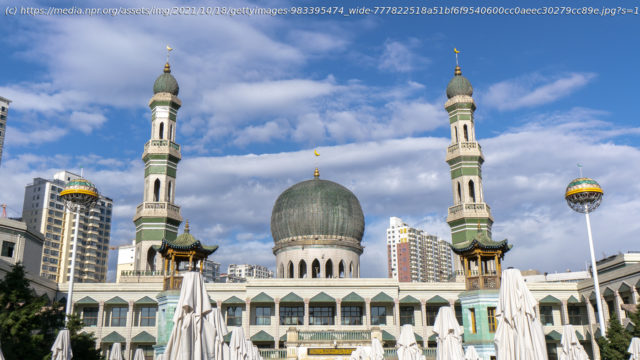XINING, China — The Dongguan Mosque has adopted some very different looks in its nearly 700 years in China’s northwestern city of Xining. Built …
XINING, China — The Dongguan Mosque has adopted some very different looks in its nearly 700 years in China’s northwestern city of Xining. Built in the style of a Chinese imperial palace, with tiled roofs and no domes, and adorned with Buddhist symbols, the mosque was nearly destroyed by neglect during political tumult in the early 20th century. In the 1990s, authorities replaced the original ceramic tiles on the roof and minarets with green domes. This year, provincial authorities lopped off those domes. „The government says they want us to ’sinify‘ our mosques, so they look more like Beijing’s Tiananmen Square,“ says Ali, a Muslim farmer selling pomegranates outside the mosque. He requested that NPR use only his first name because residents have been ordered not to speak about the dome removals. „I think the mosque looks good either way, but what say do we have anyways?“ China is removing the domes and minarets from thousands of mosques across the country. Authorities say the domes are evidence of foreign religious influence and are taking down overtly Islamic architecture as part of a push to sinicize historically Muslim ethnic groups — to make them more traditionally Chinese. The campaign comes amid rising Islamophobia in China and growing religious restrictions, touching off a discussion across the country among scholars, ethnic policy regulators and historically Muslim Chinese communities about what exactly should be considered „Chinese“ to begin with. China’s ethnic policy is directly modeled on the Soviet approach, classifying citizens into 55 distinct ethnic minority groups, each of which, in theory, is granted limited cultural autonomy within its territory. But experts say the Communist Party under Xi Jinping’s rule has shifted to a new approach, one that favors integration and assimilation — a process dubbed „sinicization“ in official speeches and documents. „A very liberal or positive view of all this [sinicization] is just basically to compare it to, say, what’s it like to become an American citizen? You accommodate and people adjust,“ says Dru Gladney, an expert on Islam in China at Pomona College. After more than 1,300 years of living and intermarrying in China, Hui Muslims — who number about 10.5 million, less than 1% of China’s population — have adjusted by becoming culturally and linguistically Chinese. They even made their version of Islam accessible to Confucians and Daoists — trying to show it as inherently Chinese and not a foreign influence — by adopting spiritual concepts and terms found in ancient Chinese philosophy to explain Islamic precepts. Various Hui sects have also incorporated Chinese religious practices into their worship, such as burning incense at religious ceremonies. Hui communities in central Henan province are even known for their female-only and female-led mosques, believed to be a uniquely long tradition in China.






